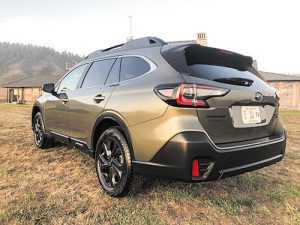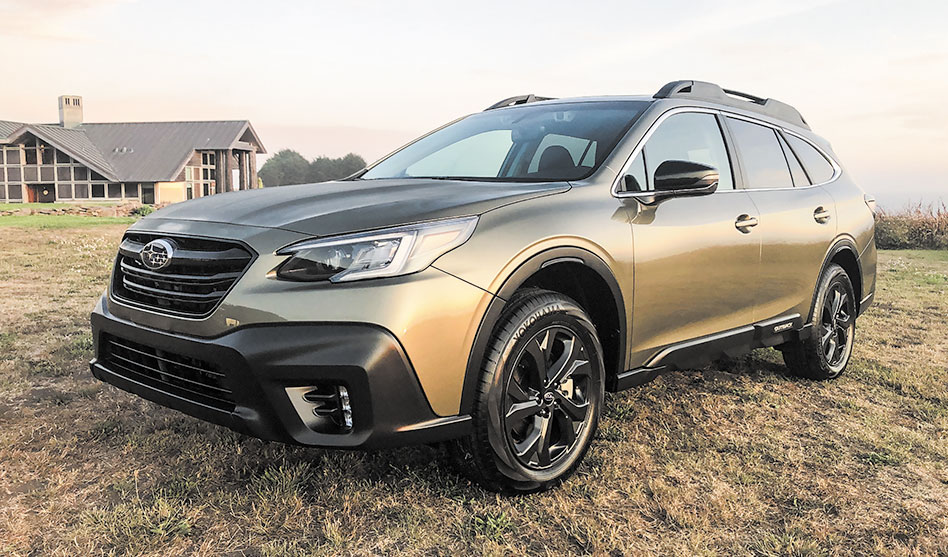The redesigned Subaru lives up to the legend
CASEY WILLIAMS | Auto Reviewer
autocasey@aol.com
Subaru could have radically changed the Outback for 2020. The design team explored options from super sleek wagons to upright crossovers that would make the proverbial outhouse look aerodynamic. Yet when they discussed what current and potential owners wanted, it was obvious the shape should look like, well, an Outback. Sure, drivers expected all of the latest safety and infotainment gear, and had desires for sportier versions with a more refined ride, but they expect it to look like a jacked wagon.
I traveled to Northern California last summer to see if the redesigned wagon lives up to its legend.
Product planners wrestled with the car’s magic formula. Safety, reliability and all-wheel-drive capability were at the top of the list. It provides the fuel efficiency of a compact crossover, the interior space of a mid-size crossover, and the drivability of a passenger car. Unlike most crossovers, owners can stand on the ground to loft bicycles and kayaks to the luggage rack, bespoke with built-in crossbars and newly added tie-downs. A reward for being unique, Subaru sells about 200,000 per year — serious volumes for station wagons.
 Returning from the previous generation are base, Premium, Limited and Touring editions plus a new Onyx XT trim that is the sportiest version, with black grille, black wheels, blacked-out logos, full-size spare tire, and a loaded interior with faux leather and lime green stitching. The last is aimed at a younger audience, which it surely will garner. It’s my favorite.
Returning from the previous generation are base, Premium, Limited and Touring editions plus a new Onyx XT trim that is the sportiest version, with black grille, black wheels, blacked-out logos, full-size spare tire, and a loaded interior with faux leather and lime green stitching. The last is aimed at a younger audience, which it surely will garner. It’s my favorite.
Aficionados will notice a more streamlined body, LED headlamps, vertical LED foglights and restyled taillamps. Wheelwells are now protected by gray plastic. Inside, an available 11.6-in. tablet style touchscreen enhances function while proper volume, tuning and seat controls maintain simplicity of use. Apple CarPlay, Android Auto, Wi-Fi, Bluetooth and eight USB ports let owners connect almost anything. Smartphones can be charged wirelessly, too.
Subaru’s twin-camera EyeSight crash avoidance system — which includes adaptive cruise, stop-and-go, lane centering, blind spot warning and auto braking — is standard. There’s also reverse auto braking and a new facial recognition system that alerts drivers when they seem drowsy. A new front camera aids trail carving. Slightly increased interior dimensions and new hands-free power liftgate add convenience.
Going into 2020, the Outback employs two engines: A 2.5-liter delivering 182 horsepower or an optional 2.4-liter turbocharged 4-cylinder conjuring a peppy 260 horsepower. Fuel economy has been an Outback hallmark and remains so. Base engines deliver 26/33-MPG city/highway while the turbo nets 23/30-MPG. Both route power to the standard all-wheel-drive system through a continuously variable automatic transmission.
We drove the Outback all day in and around the Redwood Forest, including nine miles of strenuous off-road trails. It maintains 7.8-in. of ground clearance to conquer obstacles that would embarrass some seriously capable SUVs and pushed through hairpin turns on Highway 1 along the Pacific. Between, there was time to stomp the engines and explore the Outback’s inner kitsch by driving through a giant redwood tree.
Base models start at $26,645 while the most popular Premium trim rises from $28,895. Onyx XT editions cost $34,895 while top Touring XT versions reach $39,695. In all forms, that’s an incredible value.













